Hamsi-Name
Flavors from the Black Sea
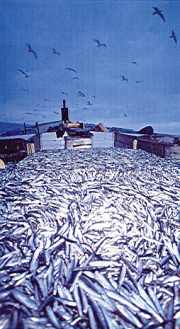 To be honest I thought it was a joke when I first heard about
it. Perhaps it originally began as one. It was the Hamsi-Name (Book of the
Anchovy) by Hamamizade İhsan published in 1928. The book discusses every
imaginable aspect of the anchovy, which has played a central role in the traditional
economy and cuisine of the Black Sea region for long centuries. The section which concerns
us particularly here is that entitled The Anchovy in the Kitchen and on the Table
which gives a large number of recipes for anchovies, including stuffed fried anchovies,
anchovy omelet, anchovies piyaz, anchovy kebap, anchovy birds, anchovies in
brine, pide (flat bread) with an anchovy filling, anchovy stock and many others. Hamsi
kuşu (anchovy birds) is described by Hamamizade as follows: To be honest I thought it was a joke when I first heard about
it. Perhaps it originally began as one. It was the Hamsi-Name (Book of the
Anchovy) by Hamamizade İhsan published in 1928. The book discusses every
imaginable aspect of the anchovy, which has played a central role in the traditional
economy and cuisine of the Black Sea region for long centuries. The section which concerns
us particularly here is that entitled The Anchovy in the Kitchen and on the Table
which gives a large number of recipes for anchovies, including stuffed fried anchovies,
anchovy omelet, anchovies piyaz, anchovy kebap, anchovy birds, anchovies in
brine, pide (flat bread) with an anchovy filling, anchovy stock and many others. Hamsi
kuşu (anchovy birds) is described by Hamamizade as follows:
Soak salted anchovies in cold water for several hours, changing the
water four or five times to remove the excess salt. Then drain and strip away the
backbone, squeeze well and dust with wheat or maize flour. Chop fresh parsley, mint and
onion, season with salt and black pepper and mix and rub well together. Spread a little of
this mixture onto each opened anchovy, fold over lengthwise and squeeze firmly to close.
The result is supposed to resemble a plump bird, similarly to the way that the Nasreddin Hoca (a comical 13th century character) likened the
stork to a bird without the beak and and legs, hence the name of this dish. Then dip in
beaten egg yolk and fry well in hot butter or olive oil. Eat immediately before it has
time to fly away.
Anchovy birds and the Hamsi-Name demonstrate that the difficult conditions
of life on the Black Sea could not crush either the inhabitants sense of humor or their
creative contributions to Turkeys culinary culture. Indeed the Black Sea cuisine is
where their creativity shows up best. The enormous range of dishes is one aspect of this
creativity, as just a glance at the lists of traditional dishes of the region shows. If we
take soups, for example, there is barley soup made with barley, milk and suet, lobya
soup made with beans, tomatoes, onions and neck of lamb, pifoli made with beans,
maize flour and cows milk, husli soup made with cabbage and maize flour, and guli
soup made with cabbage, beans, onions and maize flour.
Unusual vegetable dishes are another aspect of Black Sea cuisine. Among
the first which come to mind is muhli made with chard, onions, meat, butter and
black pepper, and malahata, a dish for cold winter nights made of white beans,
mint, onions and butter.
Another characteristic of this cuisine is bread made of barley, rye and
maize as well as wheat. Then there are unleavened breads such as lavaş and tandır,
bread containing grape molasses (pekmez), and miroloto, a kind of
vegetable bread containing cabbage, chard and onion as well as maize flour. If anchovies
are added to the latter variety it is known as hamsikolo bread.
Puddings include mafuzi, made by frying wheat flour with a little
salt in olive oil, and serving it with honey and melted butter, paluze a kind of
blancmange made with wheat flour, milk, water and sugar, pepeçura made with
grape juice and wheat flour, and termoni made with grape molasses, korkota
and white beans.
Instead of allowing this mountainous terrain with very little fertile soil
for cultivation to cramp their culinary style, the inhabitants have poured their
creativity and humor into cooking with the limited ingredients available.
Now to return to anchovies, which are the most famous ingredient of this
regional cuisine:
You are an anchovy who swims the wide seas
Your cry echoes as you begin to cook
I burn with your love come to my aid
I throw myself at your mercy, anchovy.
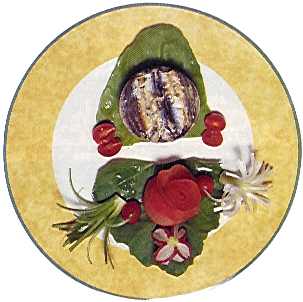 ANCHOVY
PILAV ANCHOVY
PILAV- 1 kg filleted anchovies
2 tablespoons olive oil for the pilav
250 g rice1 medium onion (finely chopped)
1/4 cup of water
1/2 cup olive oil
50 g pine nuts
50 g currants
1 tablespoon sugar
1 teaspoon cinnamon
1 teaspoon thyme
1 tablespoon mintsalt and pepper.
- Pour sufficient scalding water over the rice to cover, stir in a tablespoon of salt and
leave to cool. Meanwhile put the chopped onions and 1/4 cup of water into a saucepan and
cook over a medium heat for 10 minutes. Add the olive oil and continue to cook for a few
minutes. Drain the rice, add and cook for 5-6 minutes. Mix in the currants, pine nuts, 1.5
cups of nearly boiling water and sugar, cover, and cook over a medium heat for 10
minutes.Stir in the other spices, cover and leave for 10 minutes. Meanwhile grease an
earthenware casserole and line the base and sides with just over half the anchovy fillets
skinside outwards. Pour the rice mixture into the center and cover the surface with the
remainder of the anchovies. Sprinkle a little olive oil over and bake for 30-40 minutes at
200 degrees Centigrade.
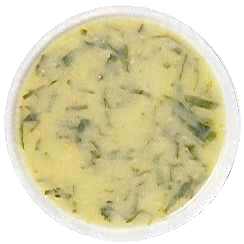 GULİ
SOUP GULİ
SOUP- 500 g of dark green cabbage leaves (finely chopped)
250 g white beans (soaked overnight)
100 g suet or lard
100 g stewed lamb
2 tablespoon maize flour
1 medium onion (finely chopped)
1.5 litres chicken stocksalt and pepper.
- Melt suet and fry the onions over a high heat for 3 minutes. Stir in the maize flour and
continue to fry for a few minutes. Slowly add the chicken stock and bring to the boil.
Season to taste, cover and simmer for 35 minutes. (We thank Mr. Vedat Başaran and Feriye
Restaurant for the recipes.)
- ANCHOVY RISSOLES
- 1/2 kg fresh anchovy fillets (finely chopped)
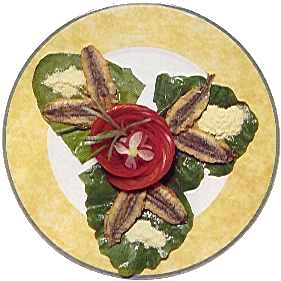 2 tablespoon parsley (finely chopped) 2 tablespoon parsley (finely chopped)
1 tablespoon fresh mint (finely chopped)
4 cloves garlic (crushed)
3 slices stale bread (soaked in water and squeezed) maize flour salt and pepper oil to fry
- Mix the chopped anchovies, herbs, spices, bread and garlic thoroughly, form into flat
oval rissoles, dip in maize flour and fry in hot oil.
- MİROLOTO
- 1 kg maize flour
250 g butter
30 g salt
30 g baking powder
2.5 cups water
250 g of dark green cabbage leaves (finely chopped)
250 g of chard (finely chopped)
1 medium onion (finely chopped)
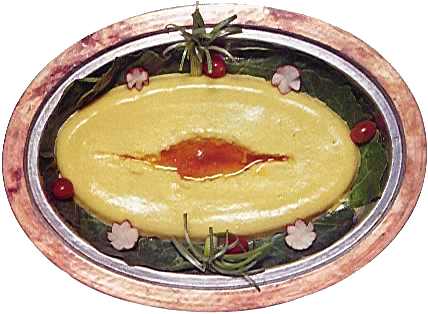 Mix the
flour, salt and baking powder. Form a hollow in the centre and toss in diced butter.
Gradually pour in the water and stir thoroughly into the butter. Add the other ingredients
and mix into a dough. Place the dough into a greased saucepan and cook over moderate heat
for 40 minutes. Mix the
flour, salt and baking powder. Form a hollow in the centre and toss in diced butter.
Gradually pour in the water and stir thoroughly into the butter. Add the other ingredients
and mix into a dough. Place the dough into a greased saucepan and cook over moderate heat
for 40 minutes.
- Source:
- Flavors from the Black Sea
By Ali Esad Göksel,
Skylife 09/98
|